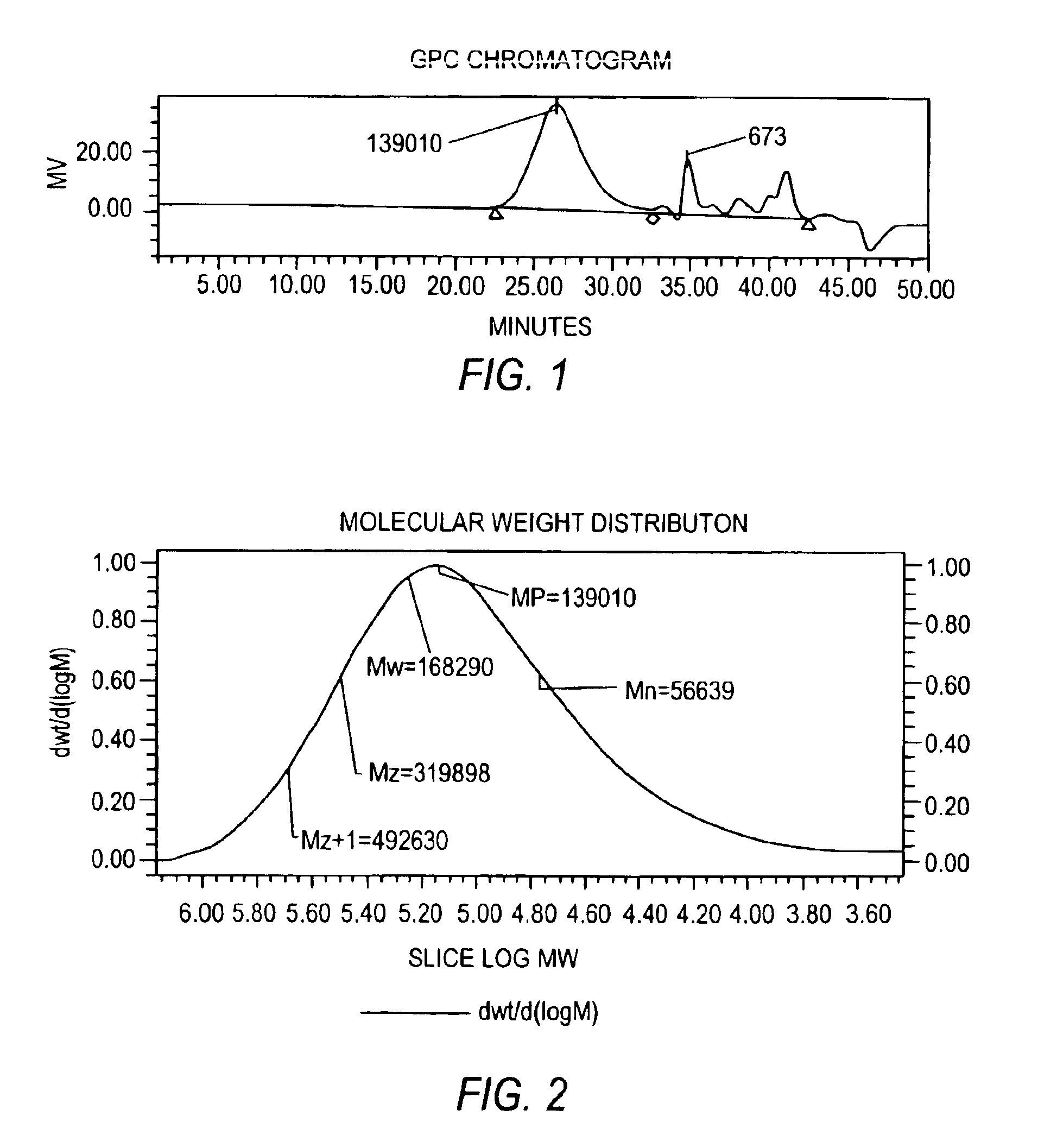Galactomannan compositions and methods for making and using same
a technology of galactomannan and composition, applied in the field of hydroxypropylgalactomannan, can solve the problem that none of these publications provides a method for preparing
- Summary
- Abstract
- Description
- Claims
- Application Information
AI Technical Summary
Benefits of technology
Problems solved by technology
Method used
Image
Examples
example 1
Preparing Guar Splits and Derivatization
[0041]Guar splits, obtained by removing the hulls and germ from guar seeds, were purchased from Hindustan Gum Limited, India. One hundred forty-one gallons of cold water were mixed with 280 lbs of a caustic mix (120 lbs water, 160 lbs of 50% NaOH) in a pressurized ribbon blender at 6-60 rpm. Swelling of the guar splits was accomplished by adding 2000 lbs of the guar splits to the above solution, mixing for 10 minutes, and then replacing the air in the reactor with nitrogen gas by evacuation. The reaction was cooled to less than 105° F. and the pressure in the reactor was adjusted to −8 psig.
[0042]To this mixture, 500 lbs of propylene oxide was added, mixed for 10 minutes, and then heated to 140° F. with continuous agitation in the same blender until the pressure in the blender reached 0 psig (1 atm). Nitrogen gas was added to the reaction up to +10 psig. The mixture was blended another 20 minutes and then cooled to 140° F. The reactor was vent...
example 2
Depolymerization of Hydroxypropyl Guar
[0043]The base was then transferred to a 10 K or a 20 K blender (10 K Horizontal Ribbon Mixer S5412 from S. Howes Co., Inc.) and heated to about 100° F. but generally not greater than 110° F. The starting temperature of the depolymerization reaction was typically 100 to 120° F. Depolymerization of the HPG was achieved by spraying the base with an amount of H2O2 solution, typically a 28% or 35% solution. The amount of H2O2 solution was approximately the equivalent of the amount of 100% H2O2 that approximates 0.25-5% of the weight of the total depolymeration reaction mixture. For example, a 35% H2O2 solution could be sprayed in one dose (200 lbs 35% H2O2 solution / 5000 lbs base) or in two doses (100 lbs 35% H2O2 solution / 5000 lbs base applied twice) with mixing in between dosing.
[0044]The temperature in the blender was allowed to heat up to 130-150° F. to react the peroxide. At 140° F., the hydrogen peroxide reacts in approximately 30 minutes. The ...
example 3
[0052]The viscosity of the HPG powder was periodically tested throughout the depolymerization process by preparing a 2.5% solution of the depolymerized HPG powder (moisture corrected) and testing it in a Fann 35 viscometer with Rotor 1 Bob 1 combination at 300 rpm (511 / sec) and 25° C. The viscosities of the liquid concentrates of depolymerized HPG were generally measured by testing a portion of the liquid concentrate in a Brookfield RV at 20 rpm with spindle #6,7 or LV#3 (cylinder).
Gel Permeation Chromatography (GPC)
[0053]GPC was used to determine the weight average molecular weight (Mw), the number average molecular weight (Mn), molecular weight distribution (MWD) and the polydispersity index (PDI) for the depolymerized HPG polymers in the DHPG powder.
[0054]Briefly, depolymerized HPG samples were prepared by resuspending 0.0025 g-0.05 g of sample in a 20 ml scintillation vial and diluting to 10 g total with a 55 mM Na2SO4, 0.2% (w / v) NaN3 solution in deionized water (“mobi...
PUM
| Property | Measurement | Unit |
|---|---|---|
| Temperature | aaaaa | aaaaa |
| Fraction | aaaaa | aaaaa |
| Fraction | aaaaa | aaaaa |
Abstract
Description
Claims
Application Information
 Login to View More
Login to View More - R&D
- Intellectual Property
- Life Sciences
- Materials
- Tech Scout
- Unparalleled Data Quality
- Higher Quality Content
- 60% Fewer Hallucinations
Browse by: Latest US Patents, China's latest patents, Technical Efficacy Thesaurus, Application Domain, Technology Topic, Popular Technical Reports.
© 2025 PatSnap. All rights reserved.Legal|Privacy policy|Modern Slavery Act Transparency Statement|Sitemap|About US| Contact US: help@patsnap.com


